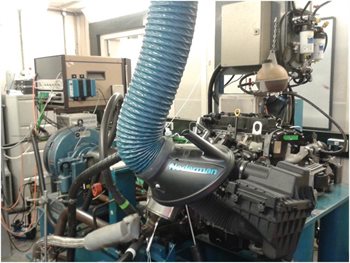FASTER Project
Fundamental Studies of the Sources, Properties and Environmental Behaviour of Exhaust Nanoparticles from Road Vehicles.
 The engine laboratory used to sample diesel engine exhaust
The engine laboratory used to sample diesel engine exhaust
Despite intensive abatement efforts over the past decades, airborne particulate matter remains a major public health issue with costs across the European Union estimated at 600 billion euros in 2005. Road traffic remains one of the major sources of particulate matter, and diesel emissions are by far the largest source of atmospheric nanoparticles in urban areas.
Semi-volatile organic compounds emitted largely in the condensed matter phase are a major component of diesel emissions, and as primary particles are advected from their road traffic source, the semi-volatile compounds vaporise and are oxidised, forming a greater mass of secondary organic aerosol (SOA). However, the semi-volatile compounds are extremely poorly characterised as they are not resolved by traditional gas chromatographic methods, presenting an unresolved complex mixture (UCM). For this reason, despite being a major precursor of SOA, such compounds are often poorly represented or completely omitted from atmospheric chemistry-transport models.
This proposal is concerned with applying new two dimensional gas chromatographic methods to characterisation of the UCM at a molecular level which will be followed by studies of the physico-chemical properties of representative components of the semi-volatile emissions. The very abundant nucleation nanoparticle mode of diesel emissions is comprised almost entirely of semi-volatile organic material and hence these particles are progressively lost from the atmosphere by evaporation. Until now, there has been insufficient knowledge of the properties of the semi-volatile components to model this behaviour reliably.
Such processes will be quantified through both controlled laboratory studies and carefully designed field measurements. Numerical models on both a street canyon and a neighbourhood (5x5 km) scale will be developed to simulate the key processes, such that spatial patterns and size distributions will be predicted, and compared with independent measurements.
Key staff
Publications
Evaporation of Traffic-Generated Nanoparticles During Advection from Source, R.M. Harrison, A.M. Jones, D.C.S. Beddows, M. Dall’Osto and I. Nikolova, Atmos. Environ., 125, 1-7 (2016). doi: 10.1016/j.atmosenv.2015.10.077
Using Variable Ionisation Energy Time-of-Flight Mass Spectrometry with Comprehensive GC×GC to Identify Isomeric Species, M.S. Alam, C. Stark and R.M. Harrison, Analytical Chemistry, 88, 4211-4220 (2016). doi: 10.1021/acs.analchem.5b03122
Recent Advances in the Application of 2-Dimensional Gas Chromatography with Soft and Hard Ionisation Time-of-Flight Mass Spectrometry in Environmental Analysis, M.S. Alam and R.M. Harrison, Chem. Sci., 7, 3968-3977 (2016). doi: 10.1039/c6sc00465b
The Characterisation of Diesel Exhaust Particles – Composition, Size Distribution and Partitioning, M.S. Alam, S.Z. Rezaei, C.P. Stark, Z. Liang, H.M. Xu and R.M. Harrison, Faraday Discuss., 189, 69-84 (2016). doi: 10.1039/c5fd00185d
Modelling Component Evaporation and Composition Change of Traffic-induced Ultrafine Particles During Travel from Street Canyon to Urban Background, I. Nikolova, A.R. MacKenzie, X. Cai, M.S. Alam and R.M. Harrison, Faraday Discuss., 189, 529-546 (2016). 10.1039/c5fd00164a